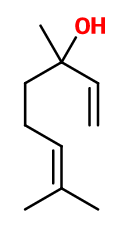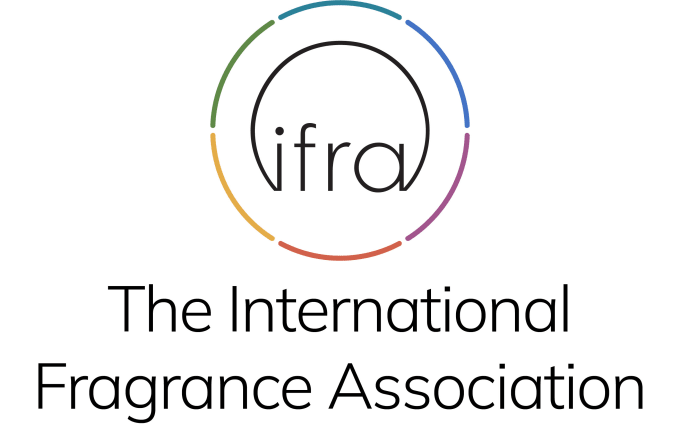
Photo credits: ScenTree SAS
| Company | Ingredient Name | ID | Comments | Naturality | Certifications | Purity | Latin name | Treated part | Geographical origin | MOQ |
|---|---|---|---|---|---|---|---|---|---|---|
|
|
Linalol - 30 Gr | - |
Visit website
|
- | - | - | - | - | - | |
|
|
Linalool | 30034999 |
Visit website
|
Molecule | - | - | - | - | - | |
|
|
Linalool BMBcert™ | 30786546 |
Visit website
|
Molecule | - | - | - | - | - |
General Presentation
-
CAS N° : 78-70-6
-
EINECS number : 201-134-4
-
FEMA number : 2635
-
FLAVIS number : 02.013
-
JECFA number : 356
-
Appearance : Colorless liquid
-
Density : 0,862
-
Volatility : Head/Heart
-
Price Range : €
Physico-chemical properties
-
Molecular formula : C10H18O
-
Molecular Weight : 154,25 g/mol
-
Log P : 2,7
-
Fusion Point : 81°C
-
Boiling Point : 199°C
-
Detection Threshold : 6 ppb (0,0000006%)
-
Optical rotation : Donnée indisponible
-
Vapor pressure : Donnée indisponible
-
Refractive Index @20°C : Donnée indisponible
-
Acid Value : Donnée indisponible.
-
Flash Point : 81°C
Uses
Uses in perfumery :
Linalool gives richness and naturalness to floral notes. Used in several floral reconstructions for a fresh and floral character. Linalool is one of the most widely used molecules in perfumery.
Year of discovery :
synthesized for the first time in 1919. Levorotatory Linalool extracted from rosewood was anyway used for the first time in 1889 in Jicky, by Guerlain.
Natural availability :
Linalool can be extracted from many natural compounds, as it is very often present in nature. The laevorotatory Linalool is present up to 85% in Camphor Wood EO and about 80% in Rosewood EO. Dextrorotatory Linalool is present up to 70% in Coriander Seed EO.
Isomerism :
The difference in smell between the two enantiomers of Linalool is quite small. Laevorotatory Linalool (Licareol) is woodier. In most cases, the racemic mixture of the two enantiomers (dextrorotatory Linalool is called Coriandrol) is used in perfumery. Several constitutional isomers of Linalool exist: Geraniol, Nerol, Eucalyptol and Rose Oxide are among them, but they all have very different smells.
Synthesis precursor :
Linalool is the precursor to the synthesis of many compounds of olfactory interest. In an acid medium, Linalool isomerizes in Geraniol, Nerol and alpha-Terpineol. The presence of chromic acid with Linalool oxides it into Citral. Linalool Oxide is obtained by its oxidation in the presence of peracetic acid. A catalytic hydrogenation of Linalool allows to synthesize Tetrahydrolinalool. Finally, several Linalool esters exist: Linalyl acetate remains the most widely used and renowned of all.
Synthesis route :
Linalool can be produced in many different ways. A first synthetic route starts from alpha-Pinene, hydrogenated in pinane catalytically. Pinane is then catalytically re-oxygenated to give a mixture of cis and trans Pinane hydroperoxides. A new catalytic hydrogenation allows to synthesize cis and trans-pinanol, separated by fractional distillation. A pyrolysis of the two separated compounds allows to obtain the two isomers of Linalool separately. Laevorotatory alpha-Pinene synthesizes dextrorotatory Linalool and dextrorotatory alpha-Pinene synthesizes laevorotatory linalool. Another synthetic route uses Myrcene, synthesized from beta-Pinene. A hydrohalogenation of Myrcene leads to the formation of geranyl, neryl and linalyl chlorides. A reaction of this mixture with copper (I) chloride gives Linalyl acetate with a yield of about 80%. Then, Linalool is obtained by saponification. Finally, 6-methyl-5-hepten-2-one, produced in several possible ways, is converted to Linalool by reaction with ethylene, synthesizing dehydrolinalool, followed by a catalysed hydrogenation by a Lindlar palladium catalyst.
Regulations & IFRA
Allergens :
This ingredient does not contain any allergen.
IFRA 51th :
This ingredient is restricted by the 51th amendment
-
Specified ingredients: notes
Oxidation products of Linalool, especially hydroperoxides, have been demonstrated to be potent sensitizers. d-, l- and dl-Linalool and natural products containing substantial amounts of it, should only be used when the level of (hydro)peroxides is kept to the lowest practical level, for instance by adding antioxidants at the time of production. The addition of 0.1% BHT or α-Tocopherol for example has shown great efficiency. Such products should have a peroxide value of less than 20 millimoles per liter, determined according to the IFRA analytical method for the determination of the peroxide value, which can be downloaded from the IFRA website (www.ifrafragrance.org).
Contributions from other sources
Natural products known to be rich in Linalool include bois de rose, coriander or ho wood oil.



